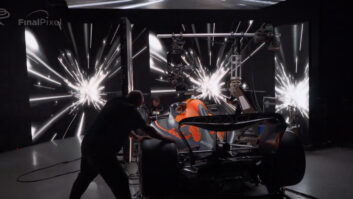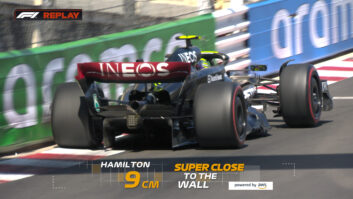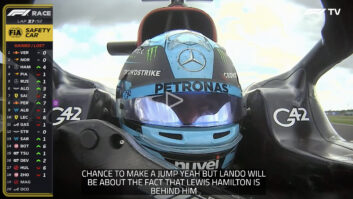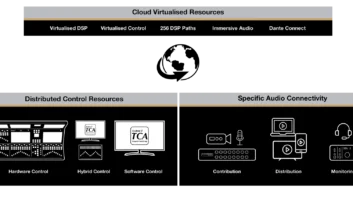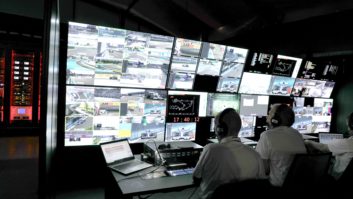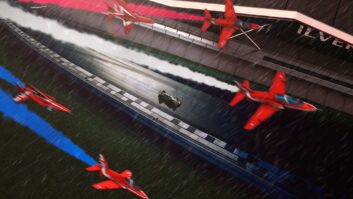Formula One is looking at developing more workflows in the cloud as it continues to innovate its TV coverage.
The sport was forced to move to a remote production workflow during the pandemic, with some members of the production team at each race track and the others at its media centre in Biggin Hill, Kent.
“We focused around acquisition at the tracks, so data, imagery, and audio; and the curation of the product is done back at Biggin Hill,” explains Formula One’s director of media and broadcast, Dean Locke.
“The problem is we’re a UHD, 4K broadcaster and that’s not going to fit down the pipe. So then you have a small sliding scale game, where you thought certain elements were staying at home, but actually they’re not.”
Locke cites the example of the track feed, which involves 30 UHD cameras: “We ended up doing the track submix on site, and then pushing it back to Biggin Hill where they can select it as a channel, and then we put HD camera signals back there that they can then use for monitoring.
“Another really good example is the high motion cameras, running at 1500 frames per second in UHD. They’re really hungry on that bandwidth so they ended up staying at the track.”
Proof-of-concepts in the cloud
The broadcast team at Formula One have worked with AWS to develop many of their remote workflows, including distributing F1 TV via the cloud.
“We’ve done some proof-of-concepts around remote operation but more cloud-based,” adds Locke. “People are obviously talking about that a lot, people are very scared of it, but we did some proof-of-concepts around some smaller outputs and I think we will start to roll some of that out.”
Another proof-of-concept being worked on at the moment is outputting the feeds to the big screens around each race track using AWS.
“I think the next part with AWS will be distribution. We still use a very traditional distribution method of satellites and uplinks using someone like EBU to hand off those signals. Things like Driver Tracker is already in the cloud, on-board channels, some of our data channels, pit lane channels, some of our extra content channels are already distributed through AWS mechanisms. We would like to do that with our world feed signals as well,” states Locke.
Innovation
As well as cloud, Locke and the team are looking at new developments around the sound of Formula One. TV coverage doesn’t begin to convey how loud the cars are. “We are talking about Dolby Atmos to run alongside the HDR pictures,” reveals Locke. “We’ve spent a lot of time in the last couple of years looking at audio around the car and we’re just designing some new on car systems and we want extra audio channels and microphones on the car.
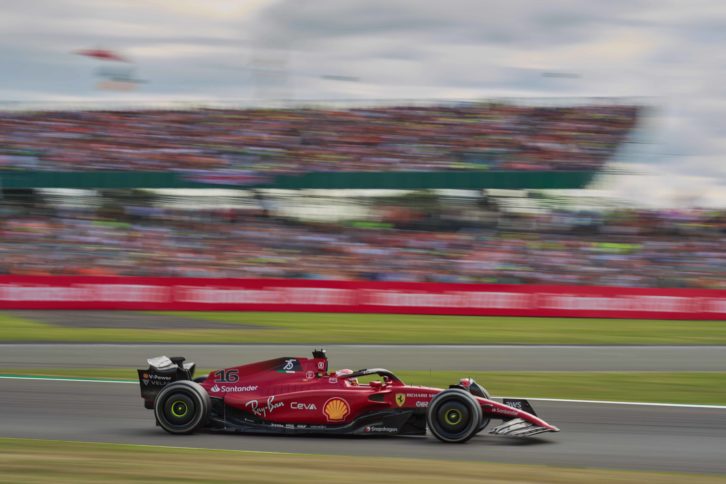
“I’d like to think we’ll have that next year but there is that shortage of equipment around the world at the moment, so lead times just seem to getting longer. I’d love to see it roll out next year but it’s quite a massive project.” he admits.
Some motorsports have begun using 5G as part of their production workflows, and Locke states that is something he wants to develop for Formula One, but it’s not easy. “Capacity off the car is a huge challenge,” he says. “We are testing 5G from helicopters. We had roving cameras in the grandstands at Silverstone. I’d like roving high-motion cameras, but that’s really hard to do unless we start looking into 5G. We’re on this massive piece of real estate, we’re not these easy peasy stadium sports!” he laughs.
All of this innovation around the way fans can watch and hear Formula One is driven (excuse the pun) from right at the top of the sport. “Stefano Domenicali and Ross Brawn are technical innovators and pioneers of Formula 1,” says Locke. “They want innovation and new things all the time. They’re pretty challenging. Normally on the plane they’ll say, what have you got new this week?”
“When I started we have 16 races, 12 in Europe and 4 international. This is pretty much a 22/23 race season if you include testing as well. It’s a challenging schedule, so development time is still pretty challenging. That’s where third parties come in. All our partners want to be involved and help us, and they want innovation.”
